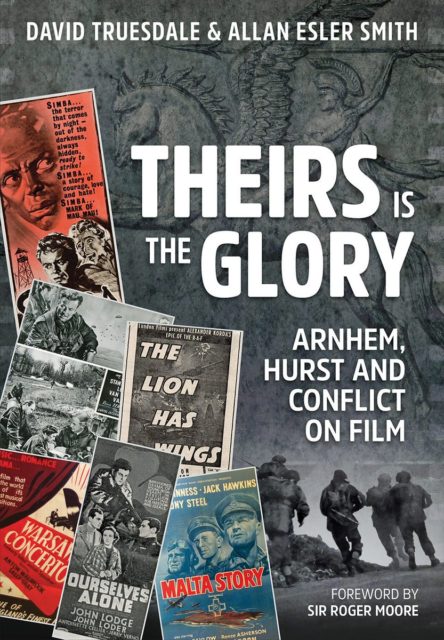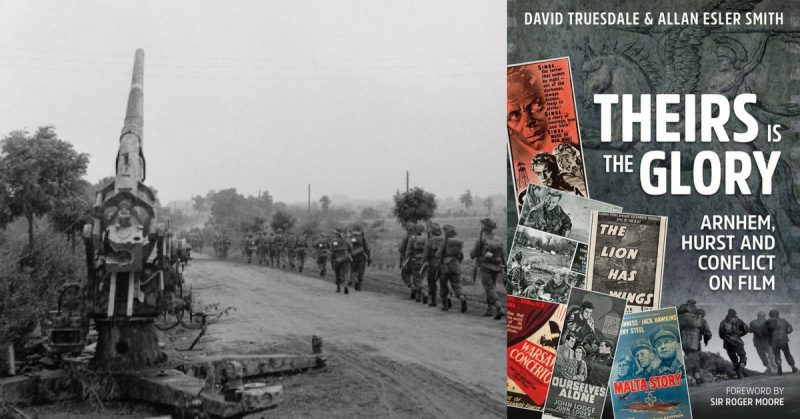The last time I saw Theirs is the Glory I was lounging in the home of my colleague Joris drinking Highland Park whisky while contemplating a couple of days on the Market Garden battlefield with my mates. The weekend turned out to be a classic and the fact it was a minimum of three years ago is frightening but so many good memories remain even if the precise date of all this eludes me.
This book looks at the making of a film that will not be familiar to all and sundry. It was made during the immediate post war period when Britain was recovering from the debilitating effort of winning the Second World War. The flush of victory was still fresh when the idea of retelling the story of the airborne assault on Arnhem was taken up. The film can be seen as something of a docudrama, with real people playing themselves and other veterans filling the roles of amalgams of key and even bit part players in the drama.
There is no dressing up the operation. It failed. End of. But even in defeat there were countless examples of heroism and the purest form of true grit. Victories win wars, but epic failure can win hearts. Nobody can take away the glow that comes from achieving an immense feat of arms in the face of the odds stacked against success. Hindsight is a wonderful thing and the flaws in the plan have become increasingly clear. Monty’s hubris has not helped, but even in defeat the reputation of the 1st British Airborne Division is assured and its legacy continues to permeate down to the modern day Parachute Regiment.
There are other films about the men who wore the red beret and, like anything else; appreciation of them is often entirely subjective. The obvious marker has to be A Bridge Too Far, the epic retelling of Cornelius Ryan’s masterpiece. Like the book the film had more to deal with than just the men at Arnhem and it remains a popular piece of entertainment, usually dragged out for rainy Sunday afternoons. Theirs is the Glory and A Bridge Too Far do not come close to each other in terms of scope and style and trying to make a comparison is an invidious task. I have no wish to even try. Both are of their time and do a job of work but despite connections in storyline they have little else in common.
Theirs is the Glory boasts a greater sense of authenticity thanks to having an unusual cast and from being made in the very locations where actual events occurred. The effect is to create a much stronger connection with the characters and the history than I found in the more recent blockbuster. It’s hard to get my head round the fact that Richard Attenborough’s film first hit our screens when I was only eighteen years old. Is it really that long ago?
But we’re slipping off track so let us get back to the reason for being here. Aside from revisiting at the battle, weaponry and key figures, the authors take a long look at the career of Brian Desmond Hurst; the gifted film director in charge of making Theirs is the Glory. Our hero was a Gallipoli veteran and a student of the great John Ford. He progressed to become an experienced director in his own right, boasting a back catalogue including Scrooge, Malta Story and Ourselves Alone, a film about the struggle for independence in Ireland. This cannot have been the easiest of subjects for an Ulster protestant but the film was a success both critically and at the box office.
But the film that sets Brian Desmond Hurst apart is Theirs is the Glory, a genuinely brilliant treatment of events at Arnhem. The film has a sense of authority about it so many war movies of the period lacked. Ok, the acting is hardly Oscar winning quality, but the timbre of the production comes across as one of calm assurance. The result is an unvarnished account where the bitter pill of defeat is not ignored. The authors of this excellent book get to grips with all this giving us an almanac of the film exuding a good deal of love and longstanding admiration.
There is a consistent feel of them falling over themselves to add more information and commentary and the personal aspect of it helps make the book come across as a long lover letter to the men of Arnhem, to the film itself and the people who made it. The effect is a bit random at times, but this is not a criticism. This book bursts with character and something harder to define. For me it is a bit like a time machine allowing the men of 1944 and, indeed, 1946; to speak directly to us. Perhaps this will only make sense if you read it yourself.
Of course this book is one hundred per cent in the zone of the Arnhem aficionados who love this stuff. It takes us to heart of people who were just ordinary men despite all the legends and myths. I can but hope that the production team of Pegasus Bridge can achieve anything like the connection forged by Theirs is the Glory.
I have visited the graves of British airborne soldiers in Sicily, Normandy and the Netherlands. There are many places where others rest. A good friend of mine recently came across some in Norway – men lost after the European war was won. The lure of the history of the red beret remains as strong as ever. Books like this add to the canon of the people who serve under the banner of Bellerophon and Pegasus.
I recently spent a day shadowing a portrait photographer working with soldiers from 3 Para at Colchester and despite the heat and a degree of resigned irritability at the arse ache of a job they had to do, the chaps were all pretty much as you might imagine. The highlight was being able to get right up close to photograph their regimental Colours. For me it was an immense privilege I will never forget even if the date becomes vague as time goes by.
The authors of this book leave us in no doubt why the film is so special and you realise that all it does is echo the men who came down from the sky in September 1944. Schmaltzy as he is to a modern audience, Rudyard Kipling gets it right when he talks of meeting with triumph and disaster. The epic of Arnhem blurs the lines but Theirs is the Glory was honest in its presentation of events and this book will help you appreciate the men, the movie and the history perhaps even more than you do already.
Reviewed by Mark Barnes for War History Online.

THEIRS IS THE GLORY
Arnhem, Hurst and Conflict on Film
By David Truesdale and Allan Esler Smith
Helion & Company
ISBN: 978 1 911096 63 4
